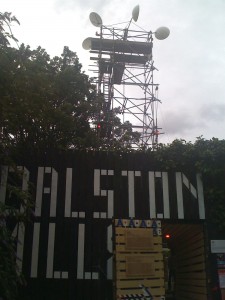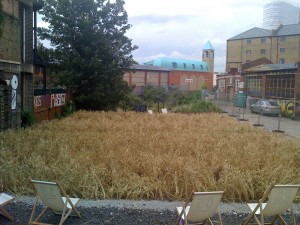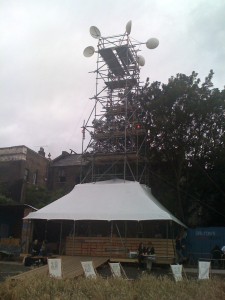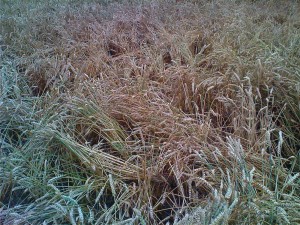Today I had one of those “I love it here” moments about London – a homespun revelation of sorts. I’ve been quite down on my chosen hometown recently, and not for any reasonable reason either – it’s a bit of an “it’s not you, it’s me” kind of thing. Anyway, I’d heard local talk about The Dalston Mill a couple of weeks back and thought it sounded like something Iain Sinclair must have missed out in his exhaustive Hackney book. Maybe I could claim something here for myself – a little piece of unmapped psychogeography just near my E8 home. Nothing to do this afternoon, I thought I should investigate further.
Research only cleared things up in a muddy kind of way. The Dalston Mill was an installation, part of the Barbican’s Radical Nature exhibition. The work is double piece featuring Agnes Denes’ Wheatfield, A Confrontation and the eponymous structure by Parisien architects EXYZT – art and nature combined. Taking place just off Dalston Lane on the site of a former railway line, the Dalston Mill was said to transplant a swaying wheatfield and a working mill into the heart of one of London’s most urban sectors. Green space is a rarity around Dalston Junction – the tube development currently taking place there puts it at even more of a premium.
Reading about it was one thing – I now had to see it for myself. Approaching the mill for anyone used to the area is a heartwarming experience. Coming in from the road, the head of the mill becomes visible – a (just about) sky-scraping wind turbine hoves into view. Atop a giant frame, there are six half spheres woozily coasting around in the breeze. At this point you stop and laugh as it’s brilliant and just plain daft at the same time. Walking in, there is a long paddock of wheat, undulating in the summer breeze. Underneath the mill there’s a bar, in front of it a set of deck chairs. Within seconds you are somewhere else, somewhere other than the edge of the Olympic development zone.
Walking up to the bar, I asked for a beer. The amiable stoner behind the counter looked puzzled and went to check. “I’ll just see if they’ve defrosted.” The internal alarm bells were smothered by the sound of laughter. He came back to tell me they were still indeed frozen but he’d happily make me a cocktail. Great attitude. On the counter, they had jars full of Dalston Slice, this being a bread based currency made from wheat from the very field in front of me. Shops in the area will exchange the bread for goods and there are courses in the daytime where you and 20 or so others bake your own Dalston Slice to spend as you see fit.
The whole exercise made me feel positive about London in a way I rarely experience these days. The Mill was inventive, random, welcoming, free-thinking, radical and – above all – fun. All at once too. The fact that the Mill is only there for three weeks (it ends on August 9th until then it’s open 2pm – 10pm and is free to enter) is a shame, but then why shouldn’t these kind of pop-ups occur everywhere, anytime? Go to places like Melbourne and they open temporary bar spaces on office block roofs, in disused haulage containers down dirty alleyways – why not shove things up here on the disused train tracks or in car parks? (and we need to check the art gallery that’s sprung up on the roof of an NCP in Peckham before it’s gone) There’s more than enough wasteground in London to erect blink-and-you-miss-’em bars, clubs, shops, whatever. I walked away with a spring in my step, my only disappointment being that I didn’t ask to try a Becks ice-pop.
Oh – the best thing about the Dalston Mill? Everyone I saw there was happy. A group of kids running about’ adults having a depressurizing afterwork drink; bar staff; everyone. In London in the middle of a recession, swine flu on every newspaper cover and mass exasperation at the tempestuous weather, that has got to be something worth smiling about.
Robin
Apologies for the weirdness of the pictures – that’ll be a combination of mobile phone camera and the early evening sun in Dalston that makes the whole place glow like Chernobyl.



